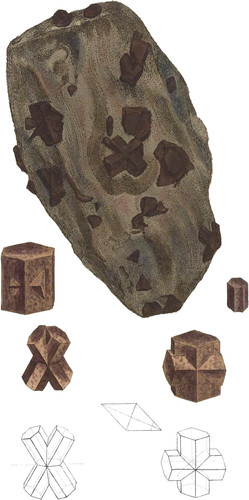 Enlarge
Enlarge
Exotic Mineralogy
Staurotide, or Granatite
- Syn.
- Granatite. Sowerby’s Catalogue of Minerals, pt. I. p. 24. Haüy. 3. 95.
- Staurotide. Haüy, 3. 93.
- Schorle cruciforme ou pierre de croix. De Lisle. 2. 434.
- Staurolith. Karsten Mineral Tabellen. 22.
When some substances come even into the most incurious hands, they become sufficiently attractive to excite admiration. This, which is found in France, Spain, and Switzerland, is mostly crystallized in hexaëdral prisms, crossing each other in pairs, either at right angles or at an angle of 60°. Sometimes these are again crossed by a third. The primitive, according to Haüy, is an upright rhomboidal prism of 1291/2°. and 521/2°. and its height to the greater diagonal of the rhomb, as 1 to 6; the acute vertical edges of which are usually truncated, making a six-sided prism; these meeting by pairs, and crossing, intersect each other on six-sided plains, placed either in right angles to each other, as in the left hand geometrical figure, or obliquely, at an angle of 60°. as in the right hand geometrical figure, elongating one of the six-sided diagonal plains.
The upper figure, with the crystals in the matrix, is by favour of my very ingenious friend, Wilson Lowrie Esq. from Brittany, and shows a great variety, which, however irregularly they seem disposed, depend on the abovementioned regularity, although they might give some idea of the accidental heaping of some other substances. The lower figures, which I have sometimes made as geometrical ones, are by favour of Dr. McCulloch.
The specimens are generally of a dark red brown colour; some are smooth and glossy, others very rough. Lustre feeble; fracture small grained and conchoidal; scarcely scratches quartz; rather brittle and frangible; not to be fused by the blowpipe. Spec. Grav. 3.2861.
| Alumine | 47.0 |
| Silica | 30.6 |
| Oxide of Iron | 15.3 |
| Lime | 3.0 |
| Loss | 4.1 |
| 100.0 |
I have a notion we shall find this substance in Great Britain, but not so fine, perhaps. Indeed I have, I presume, scraps from the north of Scotland, which will, if I get good specimens, be identified in British Mineralogy, and, if sufficiently distinct varieties, be figured there.

